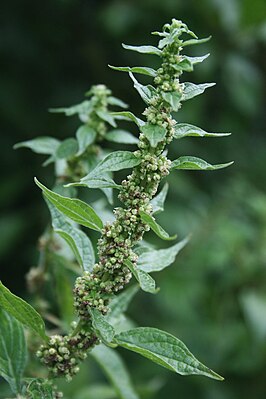Upright glass herb
| Upright glass herb | ||||||||||||
|---|---|---|---|---|---|---|---|---|---|---|---|---|

inflorescence |
||||||||||||
| Systematics | ||||||||||||
|
||||||||||||
| Scientific name | ||||||||||||
| Parietaria officinalis | ||||||||||||
| L. |
The upright glass herb ( Parietaria officinalis L. , Syn .: Parietaria erecta Mert. & WDJKoch ) is a species of the nettle family (Urticaceae). The botanical genus name Parietaria is derived from the Latin paries , parietis for wall, as this species often grows on walls. The species of the genus received the German name Glaskraut because the herb was used to clean blind glasses in the past.
features
The upright glass herb is a perennial herbaceous plant that reaches stature heights of 30 to 80, rarely up to 150 centimeters. There are no stinging hairs. The stem is erect, simply or sparsely branched. The alternate leaves are large and have a grass-like sheen, their elongated, egg-shaped blade is usually 10 to 15, rarely 5 to 20 centimeters long.
Parietaria officinalis is predominantly dioecious separately sexed ( dioecious ). There are male, female and hermaphrodite flowers. In the leaf axils there are dense, spherical inflorescences that have free bracts at the base . The inconspicuous flowers are fourfold. The stamens are initially stretched like clock springs and stretch as they open up. The fruits are black when ripe.
The flowering period extends from June to September.
The number of chromosomes is n = 7.
ecology
The upright glass herb is an archaeophyte and a ruderal plant that grows on nutrient-rich soils, but also on rubble. It is also a cultural relic that has been overgrown from former cultures. It was introduced from the Mediterranean area, where the plant is common. In South Tyrol z. B. the plant spreads further, and as a wind-flowering species it is now a dreaded allergy plant.
The fruits are up to 2 mm long, black, shiny nuts that are subject to the spread of ants. With their fruit shell, they can also spread out as balloon fliers through the wind.
The fruit ripeness extends from August to September.
Occurrence
The upright glass herb is common in central and southern Europe; it is absent in the British Isles and the Iberian Peninsula. In the north this species was naturalized by humans as far as Denmark; in Germany it is considered an archaeophyte . Hardwood floodplain forests as well as partially shaded garlic mustard, calf chervil and burdock perennial borders are settled. In Central Europe it is a character species of the Chelidonio-Parietarietum officinalis from the Alliarion association, but also occurs in companies of the Alno-Ulmion association.
In the north , the local researcher Friedrich Sundermann discovered upright glass herb in 1877 on the former site of the Dominican monastery . Its find was forgotten until the pedagogue, natural scientist and island warden Otto Leege rediscovered it in 1941. He wrote a detailed article about it with the title "Weeds that grow almost exclusively in the north, once a medicinal plant in monastery gardens, today weeds in the spit". It is considered likely that the plants are descendants of the upright glass herb, which was cultivated as medicinal plants by Dominican monks before the northern monastery was destroyed in 1531. It was used in the historical monastery pharmacy as a remedy for kidney weakness, constipation, blemishes and coughs. It was mainly given as a tea with a little mint added to cover up the unpleasant taste. Here and there, the Glauskraut leaves also served as a healing pad for tumors.
In north-west Germany the herb is only found sporadically south of Lingen . Sites in East Frisia are only available on Borkum and in the north.
use
The green parts of young plants can be eaten raw or cooked. The whole dried plant is used as a medicinal drug. The following active ingredients have not been researched so far: flavonoids, caffeic acid derivatives, bitter substances, a lot of potassium nitrate.
Applications: The drug is said to have a certain diuretic effect. Although it is still contained in a few tea blends and ready-to-use preparations, it is no longer of any significance as a medicinal plant today.
literature
- Gunter Steinbach (Ed.): Wildflowers (Steinbach's natural guide). Mosaik Verlag GmbH, Munich 1996.
- Gerhard Madaus : Textbook of biological remedies , Leipzig 1938. Glaskraut - Online.
- Ruprecht Düll , Herfried Kutzelnigg : Pocket dictionary of plants in Germany and neighboring countries. The most common Central European species in portrait. 7th, corrected and enlarged edition. Quelle & Meyer, Wiebelsheim 2011, ISBN 978-3-494-01424-1 .
- Ingrid and Peter Schönfelder : The New Handbook of Medicinal Plants, Botany Medicinal Drugs, Active Ingredients Applications , Franckh-Kosmos Verlag GmbH & Co. KG, Stuttgart, 2011, ISBN 978-3-440-12932-6
Web links
- Upright glass herb. In: FloraWeb.de.
- Profile and distribution map for Bavaria . In: Botanical Information Hub of Bavaria .
- Parietaria officinalis L. In: Info Flora , the national data and information center for Swiss flora . Retrieved October 4, 2015.
- Thomas Meyer: Data sheet with identification key and photos at Flora-de: Flora von Deutschland (old name of the website: Flowers in Swabia )
- About the medicinal effect. (engl.)
- Entry in Plants for a Future. (engl.)
- Use in folk medicine
Individual evidence
- ↑ www.floraweb.de
- ^ Erich Oberdorfer : Plant-sociological excursion flora for Germany and neighboring areas . With the collaboration of Angelika Schwabe and Theo Müller. 8th, heavily revised and expanded edition. Eugen Ulmer, Stuttgart (Hohenheim) 2001, ISBN 3-8001-3131-5 , pp. 322 .
- ^ Ostfriesischer Kurier from July 25, 1945
- ^ Karl-Theodor Schreitling: Glass herb in the monastery garden. Rare plants on North Dominican grounds . In: Heim und Herd. Supplement to the Ostfriesischer Kurier (Ed. Johann Haddinga ). 7/2007 (August 18). P. 28
- ↑ Entry in Plants for a Future. (engl.)










